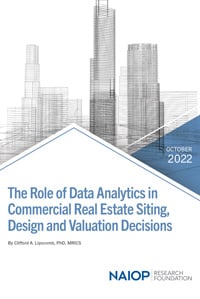New Applications for Data Analytics in Commercial Development

A new report from the NAIOP Research Foundation examines how these technologies are being used in site selection and design.
With the ever-increasing availability of digitized information, data analytics is emerging as an important aid to decision making for businesses in multiple industries. Most data-analytics applications for commercial real estate have focused on measuring the performance of existing buildings to optimize facility operations and systems. More recently, some firms have begun to use data analytics to support land and building development decisions and improve construction project outcomes.
The NAIOP Research Foundation’s October 2022 report, “The Role of Data Analytics in Commercial Real Estate Siting, Design and Valuation Decisions,” examines emerging applications for data analytics in commercial real estate development. The report’s author, Clifford A. Lipscomb, Ph.D., interviewed developers, commercial real estate services providers and CRE tech firms to evaluate the current state of data analytics adoption in the commercial real estate industry and explore applications for investors and developers.
The report reveals that most developers and investors continue to rely primarily on traditional forms of market research to inform investment decisions, but many are increasingly supplementing traditional research with data analytics. Some developers are beginning to use analytics to optimize interior layouts, amenities and other elements of building design, while others turn to analytics to narrow the range of potential sites for new speculative buildings. Experts expect that data analytics will become more widely adopted within the commercial real estate industry as relevant data become available and advances in artificial intelligence enable new applications.
Due to the high costs associated with developing data-analytics capabilities, most investors and developers currently outsource analytics tasks to consultants and CRE technology firms. Several of these firms have developed software that draws from data analytics to support key stages of the development process. Some programs can analyze the zoning and dimensions of parcels within a given municipality to support site selection and land packaging or to model multiple potential building designs that are compatible with existing zoning. Other programs track and analyze images of a site or building to support construction management or create building renderings for use in cost estimation or to market a building to buyers or tenants.
These applications have the potential to reduce project costs and shorten timelines. They may also allow development teams to test out a wider range of design options than would be feasible using traditional methods.
As analysts and programmers continue to find new uses for data analytics, it is likely they will become central to project planning and execution.
Shawn Moura, Ph.D., is research director at NAIOP.
 Get the ReportTo view and download “The Role of Data Analytics in Commercial Real Estate Siting, Design and Valuation Decisions,” visit www.naiop.org/research-and-publications/research-reports/reports/the-role-of-data-analytics-in-commercial-real-estate/ |




